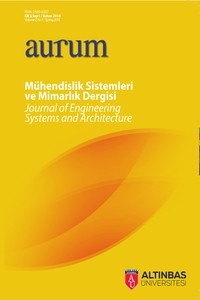Sinir Ağları ile Desen Tanıma
Desen tanıma, Sinir ağı, Kohonen, Öz-Organize harita, Sınıflandırma
Pattern Recognition Using Neural Networks
Pattern recognition, Neural network, Kohonen, Self-Organized map, Classification,
___
- Kohonen, T., 1990. Self-Organizing Map. Proceedings of the IEEE, 78(9), 1464-1480
- Germano, T., 1999. Self-Organizing Maps. Available in http://davis.wpi.edu/~matt/courses/soms/.
- Kohonen,T., 1982. Self-Organizing formation of topologically correct feature maps. Biological Cybernetics, 43, 59-69.
- Kumar, D., C.S. Rai and S. Kumar, 2008. Dimensionality Reduction using SOM based on Technique for Face Recognition. Journal of Multimedia, 3(1).
- Zurada, J.M. 1992. Introduction to Artificial Neural Systems. Jaico Books, Mumbai.
- Jamil, N., S. Lqbal and N. Iqbal, 2001. Face Recognition using Neural Networks. Proceedings. IEEE International Multi Topic Conference, 2001. IEEE INMIC 2001. Technology for the 21st Century, Lahore.
- AT&T Laboratories Cambridge, The database of faces, Available in http://www.cl.cam.ac.uk/research/ dtg/attarchive/facesataglance.html.
- Kumar, D., C.S. Rai and S. Kumar, 2005. Face Recognition using Self-Organizing Map and Principal Component Analysis, 2005 International Conference on Neural Networks and Brain, Beijing.
- Lawrence, S., C.L.Giles,A.C.Tsoi andA.D. Back, 1997. Face Recognition: Convolutional Neural Network Approach. IEEE Transactions on Neural Networks, 8(1), 98-113.
- Albawi, S., O. Bayat, S. Al-Azawi and O.N. Ucan, 2018. Social Touch Gesture Recognition Using Convolutional Neural Network. Computational Intelligence and Neuroscience, 2018, 6973103.
- Mohammed,T.A.,A.Alazzawi, O.N.Uçan and O. Bayat, 2018. Neural Network Behavior Analysis Based on Transfer Functions MLP & RB in Face Recognition. Proceedings of the First International Conference on Data Science, E-learning and Information Systems, New York, 2018, 15:1–15:6.
- ISSN: 2564-6397
- Yayın Aralığı: Yılda 2 Sayı
- Başlangıç: 2017
- Yayıncı: Altınbaş Üniversitesi
Veri Madenciliği Yöntemleri ile Uçuş Biletleme Analizi
Muhammed Metin ULUYARDIMCI, Metin ZONTUL
Yazılım Projelerinde Kalitenin Arttırılması: TMMi
Yapay Sinir Ağları ile Yüzey Sıcaklık ve Albedo Modellemesi
Elektromiyografi Sinyallerinin Sınıfılandırılmasında Kullanılan Karşılaştırmalı Metodlar
ODAY AHMED, Oğuz BAYAT, Osman Nuri UÇAN
Uyarlanabilir Cephe Sistemlerinde Şekil Hafızalı Alaşımlar ve Uygulamaları
Özge ERGİN, Zehra Canan GİRGİN
Fil Sürü Optımızasyonu Kullanılarak Dört Alanlı Yük Frekans Pid Kontrolörü Ayarlanması
Firas ALHAYANI, Aqeel S. JABER, Çağatay AYDIN, Doğu Çağdaş ATİLLA
Betonarme Yapıların Çelik Çapraz Elemanlar ile Güçlendirilmesi
